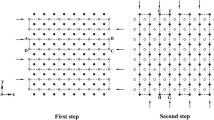The microstructure of 3D n-directional braided composites is established in this study. A theoretical method that considers 3D braided composites as assemblages of unidirectional composites is proposed to predict their elastic properties. A comparison of the predicted stiffness with experimental results showed their good agreement. The relationship between braiding parameters, including the braiding angle and fiber volume fraction, and the elastic constants is analyzed.







Similar content being viewed by others
References
B. Sun, R. Liu, and B. Gu, “Numerical simulation of three-point bending fatigue of four-step 3-D braided rectangular composite under different stress levels from unit-cell approach,” Comp. Mater. Sci., 65, 239-246 (2012).
X. Chen and Z. Li, “Analysis of the dynamic response of 3D-braided rectangular plates on an elastic foundation,” Mech. Compos. Mater., 44, 607-622 (2008).
X. Wu, J. Li, and R. Shenoi, “Measurement of braided preform permeability,” Compos. Sci. Technol., 66, 3064-3069 (2006).
F. Ko and C. Pastore, “Structure and properties of an integrated 3-D fabric for structural composites,” Recent Advances in Composites in the United States and Japan, ASTM STP 864, J. R. Vinson and M. Taya, Eds., American Society for Testing and Materials, Philadelphia, 1985, pp. 428-439.
Y. Wang and A. Wang, “Microstructure/property relationships in three-dimensionally braided fiber composites,” Compos. Sci. Technol., 53, 213-222 (1995).
J. Ya, Z. Liu, and Y. Wang, “Micro-CT characterization on the meso-structure of three-dimensional full five-directional braided composite,” Appl. Compos. Mater., 24, 593-610 (2017).
Z. Quan, Z. Larimore, X. Qin, J. Yu, M. Mirotznik, J. Byun, Y. Oh, and T. Chou, “Microstructural characterization of additively manufactured multi-directional preforms and composites via X-ray micro-computed tomography,” Compos. Sci. Technol., 131, 48-60 (2016).
J. Yang, C. Ma, and T. Chou, “Fiber inclination model of three-dimensional textile structural composites,” J. Compos. Mater., 20, 472-484 (1986).
C. Ma, J. Yang, and T. Chou, “Elastic stiffness of three-dimensional braided textile structural composites,” Composite Materials: Testing and Design (Seventh Conference), ASTM STP 893. J. M. Whitney, Ed., American Society for Testing and Materials, Philadelphia, 1986, pp. 404-421.
D. Wu, “Three-cell model and 5D braided structural composites,” Compos. Sci. Technol., 56, 225-233 (1996).
S. R. Kalidindi and E. Franco, “Numerical evaluation of isostrain and weighted-average models for elastic moduli of three-dimensional composites,” Compos. Sci. Technol., 57, 293-305 (1997).
L. Chen, X. Tao, and C. Choy, “Mechanical analysis of 3-D braided composites by the finite multiphase element method,” Compos. Sci. Technol., 59, 2383-2391 (1999).
D. Li, Z. Lu, L. Chen, L., and J. Li, “Microstructure and mechanical properties of three-dimensional five-directional braided composites,” Int. J. Solids Struct., 46, 3422-3432 (2009).
D. Li, D. Fang, N. Jiang, and X. Yao, “Finite element modeling of mechanical properties of 3D five-directional rectangular braided composites,” Composites: Part B., 42, 1373-1385 (2011).
M. Shokrieh and M. Mazloomi, “A new analytical model for calculation of stiffness of three-dimensional four-directional braided composites,” Compos. Struct., 94, 1005-1015 (2012).
G. Fang, J. Liang, B. Wang, and Y. Wang, “Effect of interface properties on mechanical behavior of 3D four-directional braided composites with large braid angle subjected to uniaxial tension,” Appl. Compos. Mater., 18, 449-465 (2011).
S. Tsai and H. Hahn, Introduction to composite materials, Lancaster: Technomic Publishing Co. (1980).
C. Chamis, “Simplified composite micromechanics equations for hygral, thermal and mechanical properties,” SAMPE Quarterly, 15, 41-55 (1984).
C. Chamis, “Mechanics of composite materials: past, present and future,” J. Compos. Technol. Res. ASTM, 11, 3-14 (1984).
R. Hill, “Theory of mechanical properties of fiber-strengthened materials,” J. Math. Phys., 12, 199-212 (1964).
Z. Hashin and B. Rosen, “The elastic moduli of fiber-reinforced materials”, J. Appl. Mech., 31, 223-232 (1964).
R. Christensen and H. Lo, “Solutions for effective shear properties in three phase sphere and cylinder models,” J. Mech. Phys. Solids, 27, 315-330 (1979).
Z. Huang, “A unified micromechanical model for the mechanical properties of two constituent composite materials, Part I: Elastic behavior,” J. Thermoplast. Compos., 13, 252-271 (2000).
Z. Huang, “A unified micromechanical model for the mechanical properties of two constituent composite materials, Part II: Plastic behavior,” J. Thermoplast. Compos., 13, 344-362 (2000).
Z. Huang, “A unified micromechanical model for the mechanical properties of two constituent composite materials, Part III: Strength behavior,” J. Thermoplast. Compos., 14, 54-69 (2001).
Z. Huang, “Micromechanical prediction of ultimate strength of transversely isotropic fibrous composites,” Int. J. Solids Struct., 38, 4147-4172 (2001).
Z. Huang, “Simulation of the mechanical properties of fibrous composites by bridging micromechanics model,” Composites: Part A., 32, 143-172 (2001).
K. Xu and X. Qian, “A new analytical model on predicting the elastic properties of 3D full five-directional braided composites based on a multiunit cell model,” Composites: Part B., 83, 242-252 (2015).
Z. Tian, Y. Yan, H. Luo, and Y. Hong, “Parameterized unit-cell models for stiffness performance analyses of threedimensional n-directional braided composites,” J. Reinf. Plast. Compos., 35, 1371-1386 (2016).
K. Xu, X. Xu, and H. Wang, “Experimental investigation of the mechanical properties of 3D 6-directional composites,” Acta Mater. Compos. Sin., 22, 145-149 (2005) (in Chinese).
D. Zhang, X. Zhen, Y. Sun, and X. Fan, “Comparative investigation of mechanical properties between 3D braided and laminated composites,” J. Aeron. Mater., 35, 89-96 (2015) (in Chinese).
S. R. Kalidindi and A. Abusafieh, “Longitudinal and transverse moduli and strengths of low angle 3-D braided composites,” J. Compos. Mater., 30, 885-905 (1996).
Author information
Authors and Affiliations
Corresponding author
Additional information
Russian translation published in Mekhanika Kompozitnykh Materialov, Vol. 55, No. 1, pp. 137-154, January-February, 2019.
Rights and permissions
About this article
Cite this article
Hong, Y., Yan, Y., Guo, F. et al. Predicting the Elastic Properties of 3D N-Directional Braided Composites Via a Theoretical Method. Mech Compos Mater 55, 95–106 (2019). https://doi.org/10.1007/s11029-019-09795-z
Received:
Revised:
Published:
Issue Date:
DOI: https://doi.org/10.1007/s11029-019-09795-z




